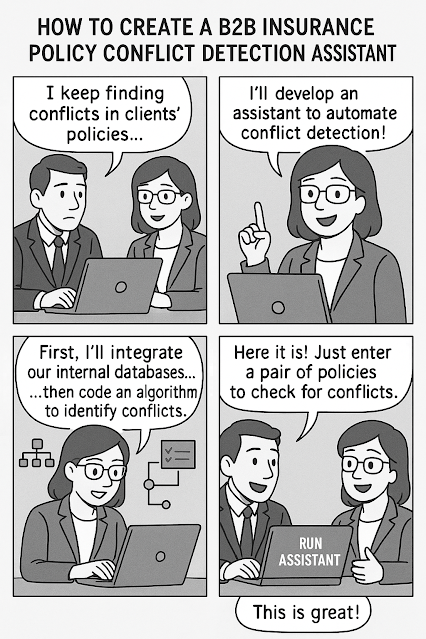How to Create a B2B Insurance Policy Conflict Detection Assistant
In the complex world of B2B insurance, conflicts can arise from overlapping policies, ambiguous terms, or compliance issues.
Implementing a conflict detection assistant can streamline operations and enhance decision-making.
Table of Contents
- Understanding Policy Conflicts
- Key Components of a Conflict Detection Assistant
- Building the Assistant
- Best Practices
- Conclusion
Understanding Policy Conflicts
Policy conflicts in B2B insurance can lead to disputes, financial losses, and reputational damage.
Common sources include overlapping coverages, inconsistent terms, and regulatory non-compliance.
Identifying these conflicts early is crucial for maintaining trust and operational efficiency.
Key Components of a Conflict Detection Assistant
To effectively detect and manage policy conflicts, the assistant should encompass the following components:
1. Natural Language Processing (NLP)
NLP enables the assistant to understand and interpret policy documents written in human language.
This facilitates the identification of conflicting terms and clauses.
2. Machine Learning Algorithms
Machine learning allows the assistant to learn from historical data and improve its conflict detection capabilities over time.
It can identify patterns and predict potential conflicts before they arise.
3. Integration with Existing Systems
Seamless integration with policy management and claims systems ensures real-time conflict detection.
This integration allows for immediate action and resolution.
4. User-Friendly Interface
An intuitive interface enables users to interact with the assistant effortlessly.
It should provide clear insights and actionable recommendations.
Building the Assistant
Creating a conflict detection assistant involves several steps:
1. Data Collection and Preparation
Gather historical policy data, claims records, and known conflict cases.
Ensure the data is clean, structured, and annotated for training purposes.
2. Developing NLP Capabilities
Implement NLP techniques to parse and understand policy documents.
This includes tokenization, entity recognition, and semantic analysis.
3. Training Machine Learning Models
Use the prepared data to train models that can detect conflicts.
Employ supervised learning with labeled examples to enhance accuracy.
4. System Integration
Integrate the assistant with existing insurance platforms using APIs.
This ensures real-time data exchange and conflict detection.
5. Testing and Validation
Conduct rigorous testing to validate the assistant's performance.
Use test cases to assess its ability to detect and resolve conflicts.
Best Practices
To maximize the effectiveness of the conflict detection assistant, consider the following best practices:
1. Continuous Learning
Regularly update the assistant with new data to improve its learning.
This ensures it adapts to evolving policy structures and regulations.
2. User Training
Provide comprehensive training to users on how to interact with the assistant.
This enhances adoption and effective utilization.
3. Monitoring and Feedback
Implement monitoring tools to track the assistant's performance.
Gather user feedback to identify areas for improvement.
4. Compliance and Security
Ensure the assistant complies with industry regulations and data protection laws.
Implement robust security measures to protect sensitive information.
Conclusion
Developing a B2B insurance policy conflict detection assistant can significantly enhance operational efficiency and reduce risks.
By leveraging NLP, machine learning, and seamless integration, insurers can proactively identify and resolve policy conflicts.
Adhering to best practices ensures the assistant remains effective and compliant in the dynamic insurance landscape.
Explore More
For further insights and tools, consider exploring the following resources:
IBM Watsonx Assistant for Insurance Botpress Insurance Chatbots Guide Scale's Insurance Claims Processing AssistantKeywords: B2B insurance, conflict detection, AI assistant, policy management, machine learning

